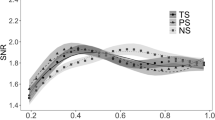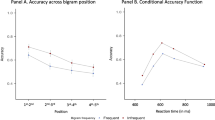Abstract
The visual N1 (N170) component with occipito-temporal negativity and fronto-central positivity is sensitive to visual expertise for print. Slightly later, an N200 component with an increase after stimulus repetition was reported to be specific for Chinese, but found at centro-parietal electrodes against a mastoid reference. Given the unusual location, temporal proximity to the N1, and atypical repetition behavior, we aimed at clarifying the relation between the two components. We collected 128-channel EEG data from 18 native Chinese readers during a script decision experiment. Familiar Chinese one- and two-character words were presented among unfamiliar Korean control stimuli with half of the stimuli immediately repeated. Stimulus repetition led to a focal increase in the N1 onset and to a wide-spread decrease in the N1 offset, especially for familiar Chinese and also prominently near the mastoids. A TANOVA analysis corroborated robust repetition effects in the N1 offset across ERP maps with a modulation by script familiarity around 300 ms. Microstate analyses revealed a shorter N1 microstate duration after repetitions, especially for Chinese. The results demonstrate that the previously reported centro-parietal N200 effects after repetitions reflect changes during the N1 offset at occipito-temporal electrodes including the mastoids. Although larger for Chinese, repetition effects could also be found for two-character Korean words, suggesting that they are not specific for Chinese. While the decrease of the N1 offset after repetition is in agreement with a repetition suppression effect, the microstate findings suggest that at least part of the facilitation is due to accelerated processing after repetition.




Similar content being viewed by others
References
Bar-Kochva I, Breznitz Z (2014) Reading proficiency and adaptability in orthographic processing: an examination of the effect of type of orthography read on brain activity in regular and dyslexic readers. PLoS ONE 9(1):e86016
Barron HC, Garvert MM, Behrens TE (2016) Repetition suppression: a means to index neural representations using BOLD? Philos Trans R Soc B 371(1705):20150355
Bentin S, Mouchetant-Rostaing Y, Giard MH, Echallier JF, Pernier J (1999) ERP manifestations of processing printed words at different psycholinguistic levels: time course and scalp distribution. J Cogn Neurosci 11(3):235–260. https://doi.org/10.1162/089892999563373
Bilker WB, Hansen JA, Brensinger CM, Richard J, Gur RE, Gur RC (2012) Development of abbreviated nine-item forms of the Raven’s standard progressive matrices test. Assessment 19(3):354–369
Brem S, Bach S, Kucian K, Guttorm TK, Martin E, Lyytinen H, Brandeis D, Richardson U (2010) Brain sensitivity to print emerges when children learn letter-speech sound correspondences. Proc Natl Acad Sci USA 107(17):7939–7944. https://doi.org/10.1073/pnas.0904402107
Chang LY, Plaut DC, Perfetti CA (2016) Visual complexity in orthographic learning: modeling learning across writing system variations. Sci Stud Read 20(1):64–85
Chang LY, Chen YC, Perfetti CA (2018) GraphCom: a multidimensional measure of graphic complexity applied to 131 written languages. Behav Res Methods 50:427–449
Dale AM, Liu AK, Fischl BR, Buckner RL, Belliveau JW, Lewine JD, Halgren E (2000) Dynamic statistical parametric mapping: combining fMRI and MEG for high-resolution imaging of cortical activity. Neuron 26(1):55–67
Dimigen O, Kliegl R, Sommer W (2012) Trans-saccadic parafoveal preview benefits in fluent reading: a study with fixation-related brain potentials. Neuroimage 62(1):381–393
Dobbins IG, Schnyer DM, Verfaellie M, Schacter DL (2004) Cortical activity reductions during repetition priming can result from rapid response learning. Nature 428(6980):316–319
Du Y, Hu W, Fang Z, Zhang JX (2013) Electrophysiological correlates of morphological processing in Chinese compound word recognition. Front Hum Neurosci 7(3):601. https://doi.org/10.3389/fnhum.2013.00601
Du Y, Zhang Q, Zhang JX (2014) Does N200 reflect semantic processing?–An ERP study on Chinese visual word recognition. PLoS ONE 9(3):e90794. https://doi.org/10.1371/journal.pone.0090794
Eberhard-Moscicka AK, Jost LB, Raith M, Maurer U (2015) Neurocognitive mechanisms of learning to read: print tuning in beginning readers related to word-reading fluency and semantics but not phonology. Dev Sci 18(1):106–118
Eberhard-Moscicka AK, Jost LB, Fehlbaum LV, Pfenninger SE, Maurer U (2016) Temporal dynamics of early visual word processing–early versus late N1 sensitivity in children and adults. Neuropsychologia 91:509–518
Garrido MI, Kilner JM, Kiebel SJ, Friston KJ (2009) Dynamic causal modeling of the response to frequency deviants. J Neurophysiol 101(5):2620–2631
Grainger J, Lopez D, Eddy M, Dufau S, Holcomb PJ (2012) How word frequency modulates masked repetition priming: an ERP investigation. Psychophysiology 49(5):604–616
Grill-Spector K, Henson R, Martin A (2006) Repetition and the brain: neural models of stimulus-specific effects. Trends Cogn Sci 10(1):14–23
Henson RN, Goshen-Gottstein Y, Ganel T, Otten LJ, Quayle A, Rugg MD (2003) Electrophysiological and haemodynamic correlates of face perception, recognition and priming. Cereb Cortex 13(7):793–805
Henson RN, Rylands A, Ross E, Vuilleumeir P, Rugg MD (2004) The effect of repetition lag on electrophysiological and haemodynamic correlates of visual object priming. Neuroimage 21(4):1674–1689
Holcomb PJ, Grainger J (2007) Exploring the temporal dynamics of visual word recognition in the masked repetition priming paradigm using event-related potentials. Brain Res 1180:39–58
Huang X, Wong WL, Tse CY, Sommer W, Dimigen O, Maurer U (2022) Is there magnocellular facilitation of early neural processes underlying visual word recognition? Evidence from masked repetition priming with ERPs. Neuropsychologia 170:108230
Koenig T, Kottlow M, Stein M, Melie-García L (2011) Ragu: a free tool for the analysis of EEG and MEG event-related scalp field data using global randomization statistics. Comput Intell Neurosci 2011:1–14
Kornrumpf B, Niefind F, Sommer W, Dimigen O (2016) Neural correlates of word recognition: a systematic comparison of natural reading and rapid serial visual presentation. J Cogn Neurosci 28(9):1374–1391
Lehmann D, Skrandies W (1980) Reference-free identification of components of checkerboard-evoked multichannel potential fields. Electroencephalogr Clin Neurophysiol 48(6):609–621
Li S, Lee K, Zhao J, Yang Z, He S, Weng X (2013) Neural competition as a developmental process: early hemispheric specialization for word processing delays specialization for face processing. Neuropsychologia 51(5):950–959
Li N, Niefind F, Wang S, Sommer W, Dimigen O (2015) Parafoveal processing in reading Chinese sentences: evidence from event-related brain potentials. Psychophysiology 52(10):1361–1374
Maurer U, Brem S, Bucher K, Brandeis D (2005) Emerging neurophysiological specialization for letter strings. J Cogn Neurosci 17(10):1532–1552. https://doi.org/10.1162/089892905774597218
Maurer U, Brem S, Kranz F, Bucher K, Benz R, Halder P et al (2006) Coarse neural tuning for print peaks when children learn to read. Neuroimage 33(2):749–758. https://doi.org/10.1016/j.neuroimage.2006.06.025
Maurer U, Brem S, Bucher K, Kranz F, Benz R, Steinhausen HC et al (2007) Impaired tuning of a fast occipito-temporal response for print in dyslexic children learning to read. Brain 130(12):3200–3210
Michel CM, Murray MM, Lantz G, Gonzalez S, Spinelli L, De Peralta RG (2004) EEG source imaging. Clin Neurophysiol 115(10):2195–2222
Recasens M, Leung S, Grimm S, Nowak R, Escera C (2015) Repetition suppression and repetition enhancement underlie auditory memory-trace formation in the human brain: an MEG study. Neuroimage 108:75–86
Rossion B, Joyce CA, Cottrell GW, Tarr MJ (2003) Early lateralization and orientation tuning for face, word, and object processing in the visual cortex. Neuroimage 20(3):1609–1624
Uno T, Okumura Y, Kasai T (2017) Print-specific N170 involves multiple subcomponents for Japanese Hiragana. Neurosci Lett 650:77–81
Wang F, Maurer U (2017) Top-down modulation of early print-tuned neural activity in reading. Neuropsychologia 102:29–38
Wang F, Maurer U (2020) Interaction of top-down category-level expectation and bottom-up sensory input in early stages of visual-orthographic processing. Neuropsychologia 137:107299
Wong AC, Gauthier I, Woroch B, Debuse C, Curran T (2005) An early electrophysiological response associated with expertise in letter perception. Cogn Affect Behav Neurosci 5(3):306–318
Zhang JX, Fang Z, Du Y, Kong L, Zhang Q, Xing Q (2012) Centro-parietal N200: an event-related potential component specific to Chinese visual word recognition. Chin Sci Bull 57(13):1516–1532. https://doi.org/10.1007/s11434-011-4932-y
Acknowledgements
This work was supported by a Direct Grant by the Faculty of Social Sciences at The Chinese University of Hong Kong (4052287) and by the National Natural Sciences Foundation of China (No. 31571140).
Author information
Authors and Affiliations
Contributions
UM, SR, and SL designed the study. SR, JZ, and PZ collected the data. RS conducted the focal electrode analyses. UM conducted the topographic analyses, created the figures, and wrote a first draft and the final version of the manuscript. BS prepared a second draft of the manuscript. All authors reviewed the manuscript.
Corresponding authors
Ethics declarations
Competing interests
The authors declare no competing interests.
Additional information
Handling Editor: Edmund Lalor.
Publisher's Note
Springer Nature remains neutral with regard to jurisdictional claims in published maps and institutional affiliations.
Rights and permissions
Springer Nature or its licensor (e.g. a society or other partner) holds exclusive rights to this article under a publishing agreement with the author(s) or other rightsholder(s); author self-archiving of the accepted manuscript version of this article is solely governed by the terms of such publishing agreement and applicable law.
About this article
Cite this article
Maurer, U., Rometsch, S., Song, B. et al. Repetition Suppression for Familiar Visual Words Through Acceleration of Early Processing. Brain Topogr (2023). https://doi.org/10.1007/s10548-023-01014-2
Received:
Accepted:
Published:
DOI: https://doi.org/10.1007/s10548-023-01014-2




